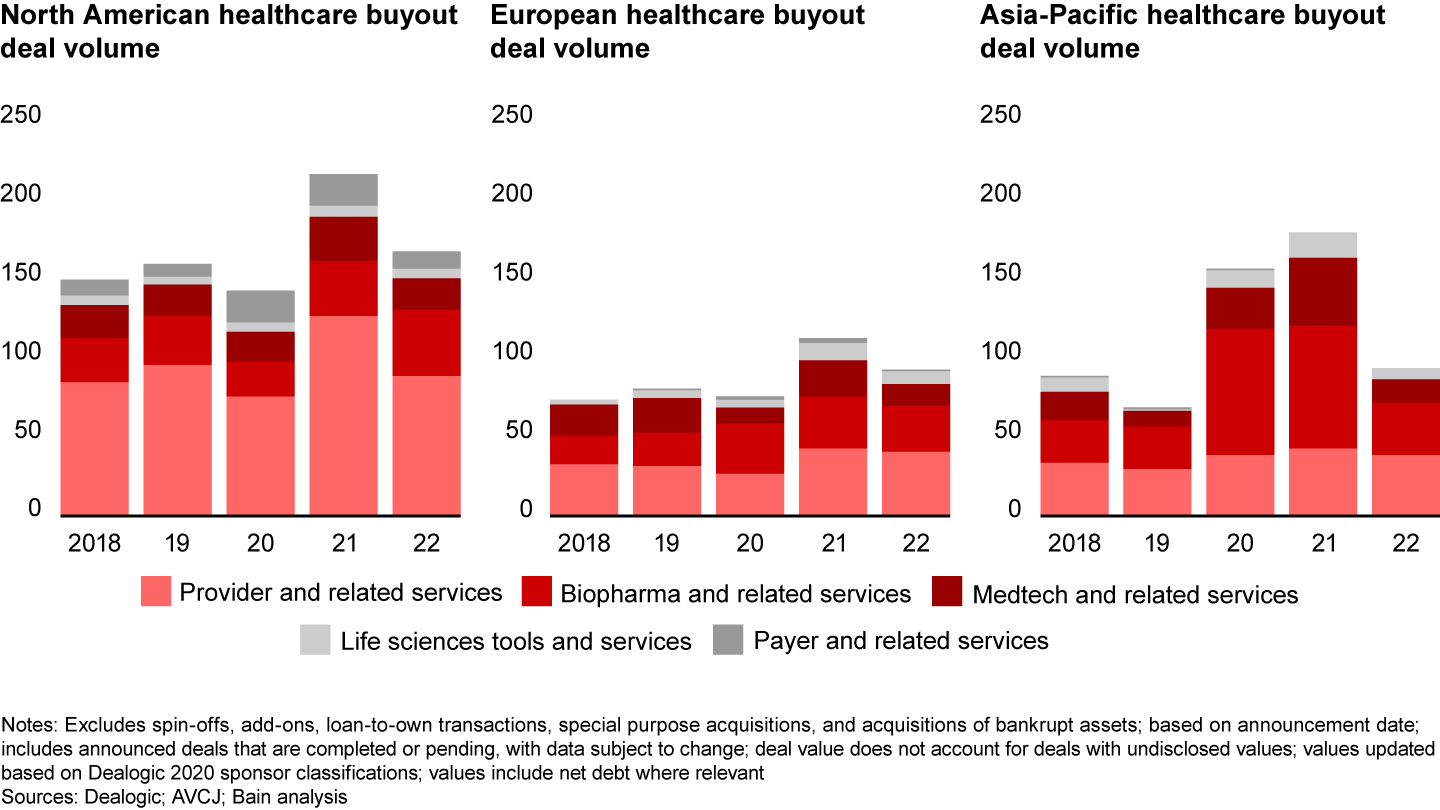Global Healthcare Private Equity Report

At a Glance
- Payer-related buyout activity declined in 2022.
- Deals reflect continued interest in technology and services businesses that perform administrative functions for payers.
- Payers identifying the right mix of outsourcing, acquiring, and partnering with related services and technology businesses will create competition and opportunity for private equity firms.
- Venture investment in innovative payer-related technology and services businesses suggests places to compete for private equity.
This article is part of Bain's 2023 Global Healthcare Private Equity and M&A Report.
Following an active 2021, payer-related buyouts cooled in 2022, with the number of buyouts dropping from 24 to 12 and disclosed deal value declining from $15.3 billion to $2.2 billion, made up entirely by TPG’s acquisition of ClaimsXten (see Figure 1). The stark divide in part reflects 2021’s outlier performance, as the number of payer-related buyouts in 2021 was roughly double that of any year between 2013 and 2019. Large deals in 2021 drove disclosed deal value to a record high, with the two biggest deals worth a combined $11.3 billion—alone enough to make 2021 the all-time best year for deal value.


While 2021 was a tough act to follow, other factors contributed to the drop in payer-related buyouts in 2022. Tight credit conditions limited financing across private equity, and antitrust litigation created uncertainty for payer-related deals specifically. Most of the drop, though, can be attributed to a scarcity of payer-related assets owing to the structure of the payer industry and the high deal volume of the previous two years.
Despite the smaller selection of deals, we highlight two trends relevant for private equity: first, the continued interest in payer services and technology, and second, corporate deal activity creating both competition and opportunities.
Continued interest in payer services and technology
Last year’s report highlighted services and technology that can help payers and health services companies contain costs. Private equity activity in 2022 continued to reflect this focus.
Buyout activity was concentrated in point solutions with more immediate expected returns rather than longer-term plays around health outcomes. Private equity showed continued interest in services and technology that allow payers and health services companies to outsource certain administrative functions. ClaimsXten, for instance, offers claims management technology and analytics tools that help payers reduce appeals, generate administrative savings, and improve payment accuracy. TPG acquired the business for $2.2 billion in a carve-out from Change Healthcare after Optum merged with Change Healthcare.
We anticipate that businesses helping payers to automate and improve efficiency will remain attractive to private equity as payers continue to invest in services and technology that enable resource optimization. During a downturn, payers are especially likely to prioritize solutions that have an immediate and measurable return on investment. Sponsors should keep this top of mind as they make new investments and manage existing portfolio companies.
Large payers create competition and opportunities for private equity
For years, large payers have been evolving into diversified health services companies. They continue to fine-tune the right mix of outsourcing, acquisitions, and partnerships with payer-related services and technology. On the one hand, corporate deal activity leads to increased competition for limited payer-related assets. On the other hand, it creates opportunities for private equity in the form of carve-outs and exit options.
Within the payer space in 2022, corporate buyers made 3.7 acquisitions for every sponsor buyout. This represents a significant jump from 2021, when corporate buyers made just under 1.6 acquisitions for every sponsor buyout. The increase in strategic activity means that sponsors face greater competition for scale assets and potential tuck-in acquisition targets. The interest in specialty insurance companies, which enable carriers to manage supplemental and noncore medical benefits more efficiently, illustrates this well. Sun Life Financial acquired DentaQuest, a provider of supplementary dental benefits, for $2.5 billion toward the end of 2021. A few months later, Welsh, Carson, Anderson & Stowe acquired a majority stake in Liberty Dental Plan, a competing provider of supplementary dental benefits, alongside Anthem (now part of Elevance Health).
Alternatively, corporate activity can create opportunities for private equity in the form of carve-outs. A notable example from 2022 was Francisco Partners’ acquisition of bswift from CVS Health. This carve-out will allow the provider of benefits technology to reach customers beyond those it acquired through the networks of Aetna and CVS Health.
Consistent with prior years, corporate buyers created a compelling exit pathway for some private equity-backed payer-related assets. New Mountain Capital’s sale of Signify Health to CVS Health in a deal worth roughly $8 billion was the most notable example. But as the line between payers and providers blurs, selling to large payers proved to be an exit option for more than just payer-related assets. As UnitedHealth Group’s Optum spent big on provider groups, it acquired Healthcare Associates of Texas for $300 million from Webster Equity Partners. Optum also bought Refresh Mental Health, a behavioral health provider group, providing an exit for Kelso & Company.
A more active deal landscape on the horizon
We expect the focus on services and tech to remain a theme in the coming years as growth assets reach critical points of scale. Growth equity and venture capital investments support this, with large financing rounds falling along the same lines as payer-related buyouts. Nayya, a benefits administration platform, raised $55 million in an investment round led by ICONIQ Growth. General Atlantic led an investment round in NationsBenefits, a supplementary benefits and member engagement business. Distribution was also of interest to investors, with both BEA Group and AmeriLife Group successfully attracting investment.
We believe investors will need to be opportunistic as assets become available, particularly those that align with the current sector themes. Solutions with a demonstrated ability to improve patient outcomes or reduce costs for payers remain compelling. Sponsors making new investments or managing existing investments in this space should keep this concern top of mind, as differentiated businesses with a demonstrable return on investment will be more likely to produce strong returns.